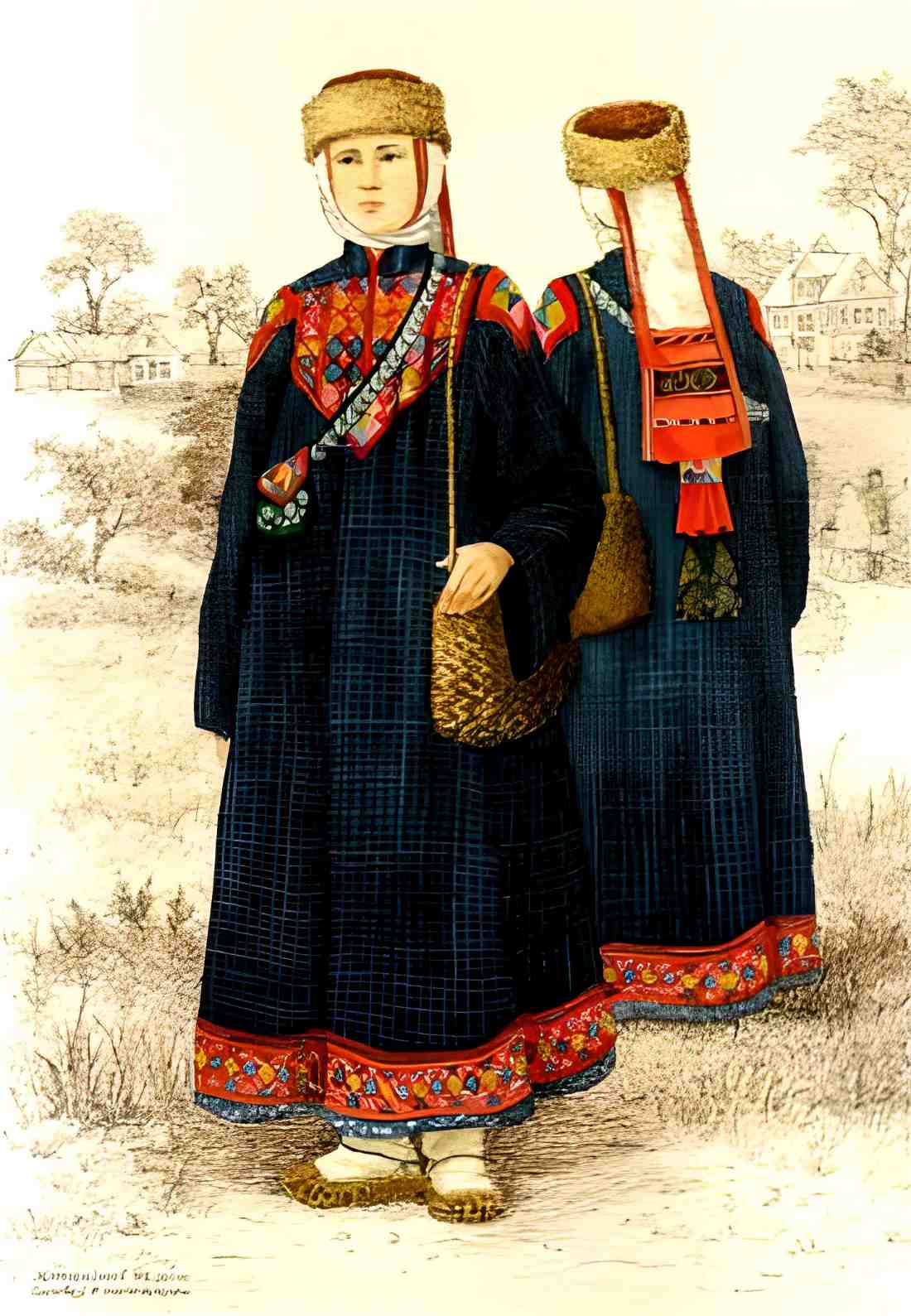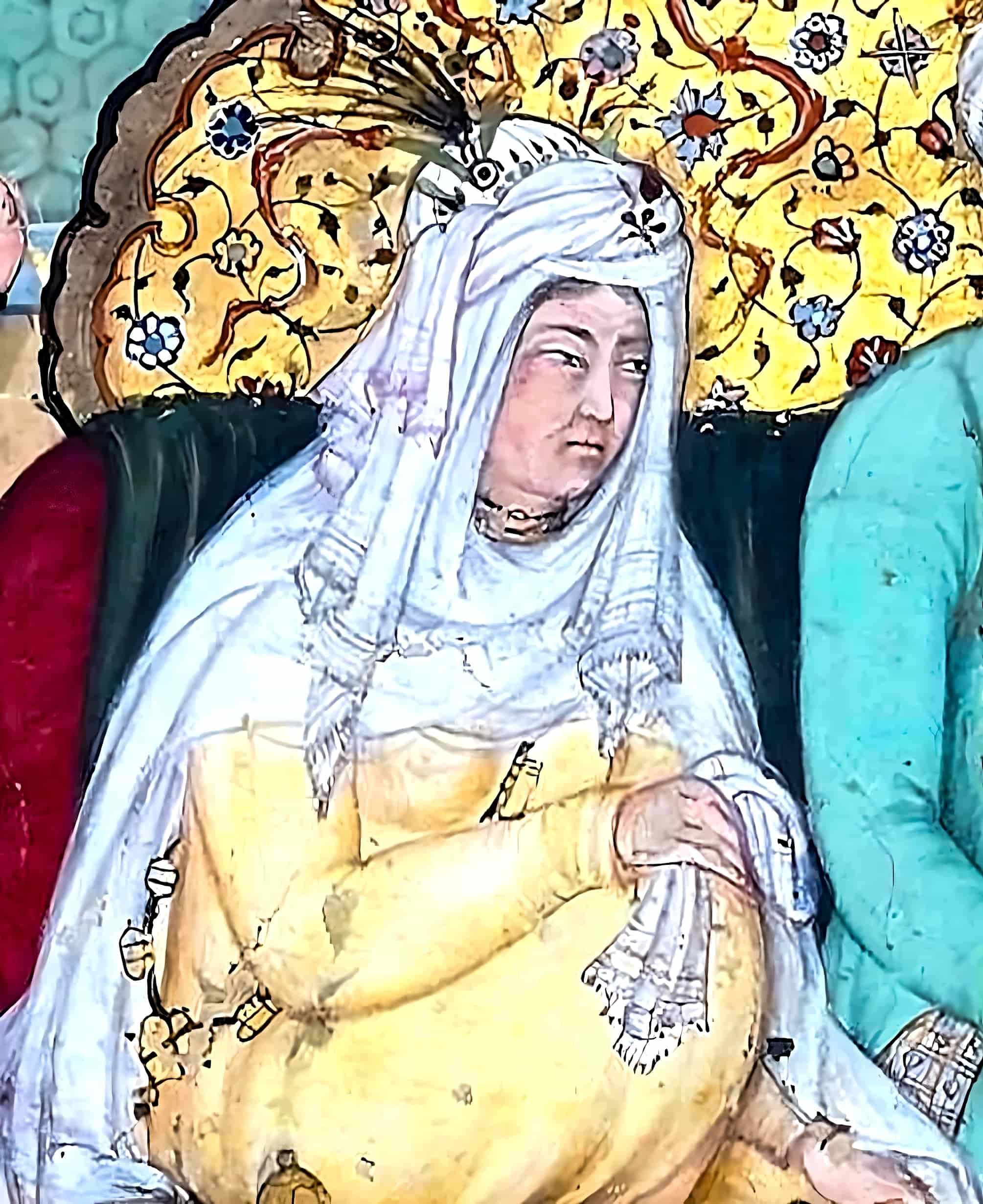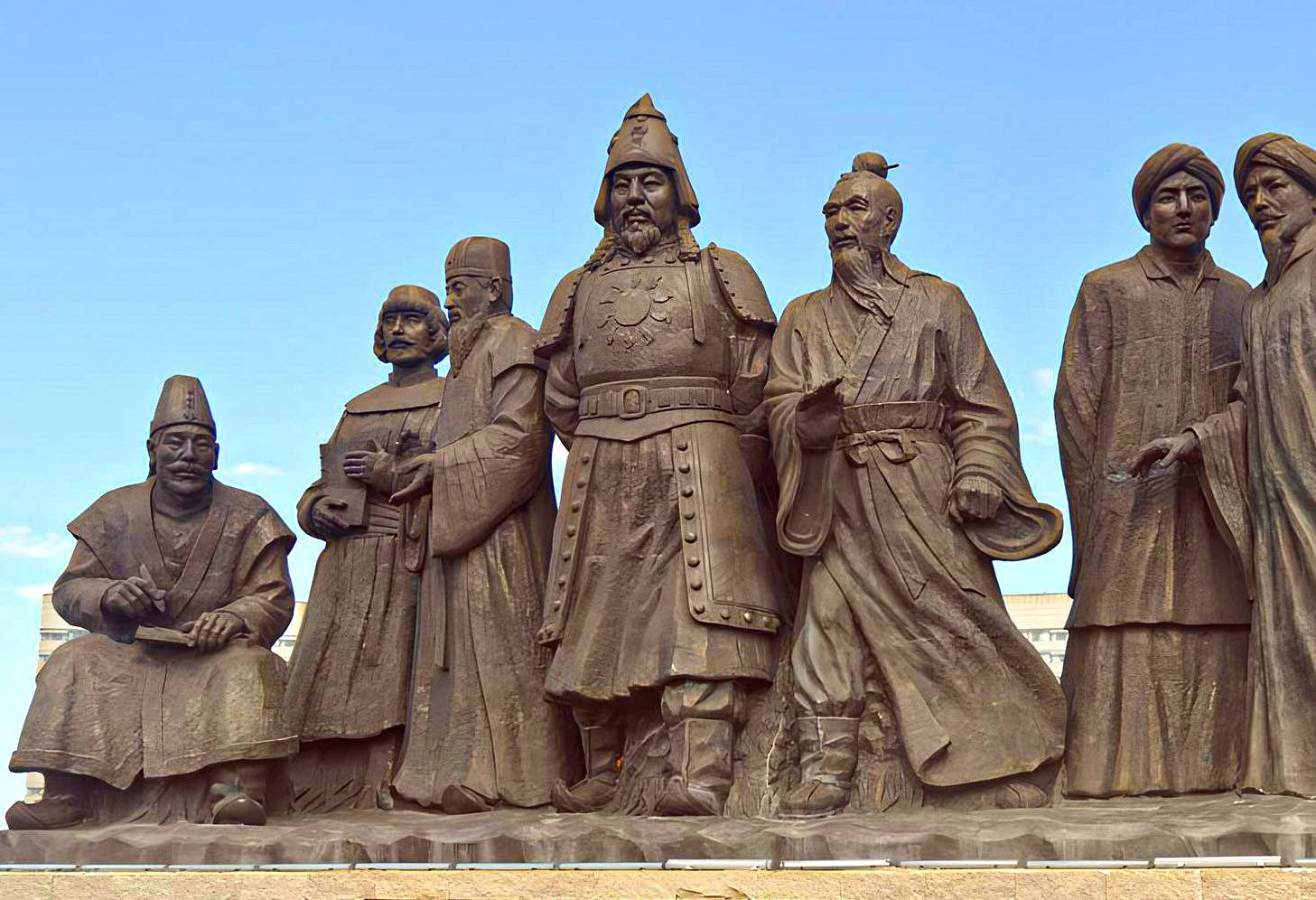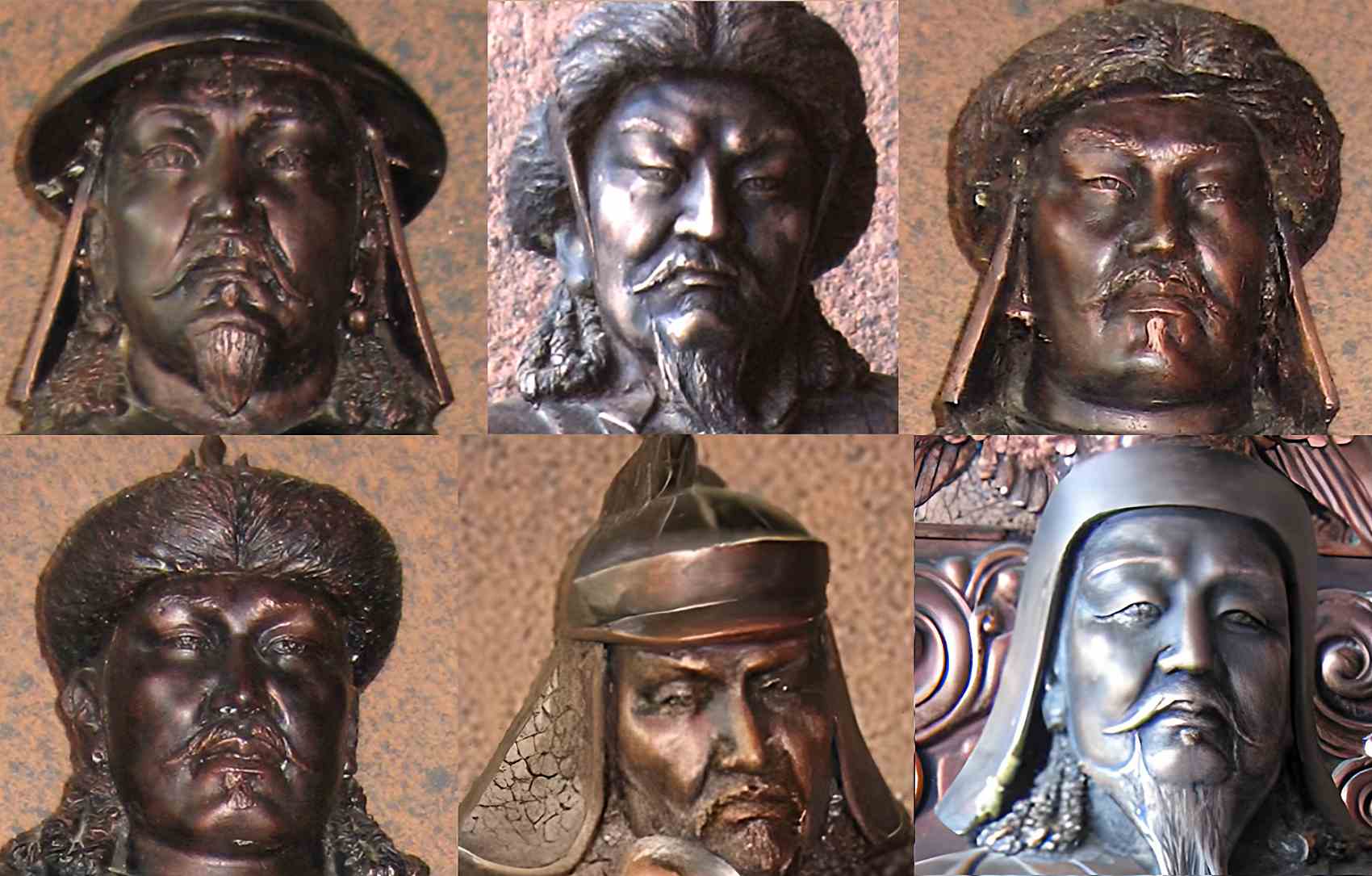Genghis Khan had seven wives. Along with his 13 official children, Temüjin (Genghis Khan) had around 120 children. They were from his seven Mongolian wives and 500 concubines of which 44 are documented including Chaga Khatun, Gurbasu Khatun, Abika Khatun, Gunju Khatun, Isukhan Khatun, Kunju Khatun and others. The nine children alone were from his first wife Börte, the Great Khatun. And Genghis Khan’s primary wives were as follows: Börte, Khulan, Juerbiesu, Yesugen, Yesui, Ibaqa, and Möge. They were the principal khatuns of the Great Khan. Let’s find out more about those wives.
During Genghis Khan’s rule, a tradition was followed where the most attractive women from each tribe were selected by Genghis Khan to be his concubines. Aside from Mongolian women, these concubines also comprised captives of other nationalities. The women selected by Genghis Khan were given to his queens or “khatuns” and also close relatives. The Great Khan’s seven primary wives operated his harems in the form of yurts which were the housings for the concubines. Genghis Khan’s concubines belonged to the “Four Great Ordos” (courts).
According to studies, 8% of men who live in or around the former Mongol Empire have the same Y-chromosome as Genghis Khan. Due to his numerous wives, Genghis Khan is the ancestor of as many as 20 million men today, or around 0.5% of all men on the planet.
Börte Khatun (l. 1161–1230)

Genghis Khan had seven first-class wives or consorts, among whom Börte Khatun was the highest-ranking. Along with the mother of Genghis, Höelun, Börte was one of the most important individuals in the life of the Khan. She was born into the Olkhonud of Khongirad in 1161, and the Olkhonud was also the tribe of Genghis’ mother. For Genghis Khan, only Börte’s sons were eligible to become the rulers of the Mongol Empire.
Her appearance
The Olkhonud tribe’s female members were renowned for having unusually stunning looks. Börte is often shown as a beautiful lady wearing a white silky gown, carrying a white lamb, wearing gold coins in her hair, and sitting atop a white horse. She was characterized as having a light complexion, fire in the eyes, and a vivid face, all of which indicated that she was bright.
Börte Khatun was the daughter of Teyin (or Dei Seichen), the 12th-century chieftain of Khongirad province. Just like Genghis, she practiced Tengrism, the ancient religion of Turks and Mongols. Temüjin and Börte married when they were 9 and 10 years old, respectively.
The kidnapping of Börte
Regarding the marriage between Temüjin and Börte, the Secret History of the Mongols states that Temüjin was favored by Teyin of the Khongirad tribe when he was still in his teens, and Teyin’s daughter Börte became Temüjin’s permitted wife. However, this is probably a fiction, and when Temüjin tried to marry Börte, Börte’s father Teyin allegedly opposed the marriage, but through the intercession of her younger brother, Archi Noyan, the couple was finally allowed to marry.
When Temüjin and Börte were still childless after their marriage, Temüjin was attacked by the Merkits, and his wife Börte was captured. However, the Khongirad tribe of Keraites decided to cooperate with Temüjin because they were sworn allies (anda) with Temüjin’s father, Yesugei, and Khongirad helped rescue Börte from the Merkits, and she was safely returned to Temüjin after staying captive for 8 months.
Börte gave birth to Jochi shortly after being rescued, indicating that she was raped by Merkits. But Genghis Khan saw the baby as his own and called him “Jochi,” which means “guest” in Mongolian. Without Khongirad’s help, Börte could have become the wife of a Merkit man, at least in the story.
The Mongols of that time had a custom of capturing married women, and it was common for the stronger tribe to capture the women of the weaker tribe, or for the tribe that won the battle to take the women of the losing tribe as wives.
Another version of the story
However, in another version of the story, Börte was already pregnant with Jochi when she was captured by the Merkit tribe, and Jochi’s father was actually Genghis Khan. In the “History of Mongolia,” Vol. 1, Part 1, it is written that when the Merkits took the opportunity to plunder the house of Genghis Khan, they sent his wife Börte, who was already carrying Jochi, to Khongirad, because peace had been established between two tribes at the time (p. 41). Thus, Börte was pregnant with Jochi when she was attacked by the Merkits.
Famously, there was also a conflict between Jochi, the firstborn, and Chagatai, the secondborn, regarding Jochi’s dubious origin. At the same time, Jochi withdraws from Genghis Khan’s battles for unknown reasons. But there is no concrete source stating that Chagatai actually accused Jochi of having questionable origins. The claim that Jochi was the son of the Merkit tribe appears to be a fiction created by the author of The Secret History of the Mongols for dramatic effect.
Börte Khatun held the Chinese title of “Üjin,” a title given to the consort of the Chinese emperor or second-in-line to the empress. She was the mother of Jochi, Chagatai, Ögedei, and Tolui, Genghis’ only apparent heir. Börte Khatun also gave birth to five daughters who became wives of tribal and provincial princes: Alakhai Bekhi, Checheikhen, Alaltun, Tümelün, and Qocin Beki (Huochenbieji).
Khulan Khatun (l. 1164–1220)

Khulan Khatun (1164–1220) was Kuoliejian’s (or Kölgen’s) mother. Among Genghis Khan’s seven wives, Khulan was second in rank to Börte, and she accompanied Genghis Khan on one of his famous western expeditions. Her son Kuoliejian was also second in status to Genghis Khan’s other sons from Börte.
Khulan Khatun was one of the wives of Genghis Khan. As the Great Khatun Börte Üjin’s second-in-command, she was known as the Second Khatun. A vassalage in the Khentii Mountains was awarded to her when she also led the Second Ordo (court) at the time. “Holan” refers to a “wild horse enclosure” and comes from medieval Mongolian.
Dairusun, a chieftain of the Uvas Merkit tribe, was Khulan Khatun’s father, and the Uvas Merkit clan was one of the Three Merkits. In 1204, when Mongolia was almost united under Temüjin, leader of the Borjigin tribe, his Mongols faced resistance from both the western Naimans and the eastern Merkits, but Genghis Khan ultimately prevailed in battle.
The Merkit chief, Toqtoa Beki, escaped, and the Uighur clan head, Dairusun, conceded defeat to Temüjin. With his surrender, the women of the Uvas were given in plunder marriages to Borjigin royalty, and Khulan became Temüjin’s wife. In 1206, at the Kurultai on the Onon River, Temüjin was crowned “Genghis Khan,” and he sealed Khulan as his second wife.
There was a child born to Khulan Khatun and Genghis Khan, and he was named Kölgen (or Kuoliejian). Genghis Khan brought Khulan Khatun on his western expeditions because he was so fond of her. Khulan Khatun became sick and died in 1220 during the Mongol invasion of India, ending the Anushtegin (or Khwarazmian) dynasty. Genghis Khan had her body buried under deep ice.
Yesugen Khatun (m. 1202)

Genghis Khan had many wives, and Yesugen Khatun was one of them. Yesugen was born in the Tatar province and married Genghis Khan through a plunder marriage when the Mongols conquered the region in 1202. After Yesugen claimed that her elder sister Yesui was just a better fit for a khan’s wife in terms of appearance and intelligence, Genghis Khan set out to find Yesui, whose whereabouts were unknown, and married her. When he did, Yesugen abdicated in favor of her sister in 1206.
Genghis Khan, impressed by Yesugen’s behavior, once again accepted her as his own wife (khatun), elevating the status of the Yesui and Yesugen sisters. The two sisters thus became the wives of Genghis Khan together. Their brothers Yeke Kutokut and Jochi were able to rise to the position of Mingghan (captain of a thousand households) in the Mongol Empire because of their sisters’ prominence as Genghis Khan’s wives.
After serving in the Third Ordo, Yesugen and her nobler elder sister Yesui Khatun were awarded the Khangai Mountains as a vassal town. This is true of each and every one of Genghis Khan’s wives. According to the narrative in “Tatar Tribes,” Genghis Khan granted permission to Yesui and Yesugen to raise two sons, Kuri and Kara (“Black”) Mangut, who were selected from the same clan. The two sons went on to become prominent military leaders in the Iranian Tanmachi Mongols, and their descendants founded the Hulagu Ulus (Ilkhanate) in 1256.
“History of Yuan” (1370) places Yesugen at the top of the Fourth Ordo, but another source puts her third in order in the list of Genghis Khan’s wives. However, considering the anecdote that Yesugen handed over her position to Yesui, it is natural to make her the head of the Fourth Ordo.
It is known that Yesugen, like her sister, accompanied her Tatar father Yeke Cheren on many journeys, but nothing more is known about her. She is believed to have died early, before her older sister did, somewhere between 1195 and 1221, after giving birth to a boy named Cha’ur who also lived only for a short time.
Ibaqa Beki Khatun (m. 1204–1206)

Kerait princess Ibaqa Beki Khatun was also a wife of Genghis Khan from 1204 to 1206. Her father, Jakha Gambhu, was the younger brother of Keraites Khan Toghrul. After Toghrul’s defeat, Jakha Gambhu and his Nestorian Christian daughter, Ibaqa Beki, went to Naiman, where Genghis Khan destroyed the tribe. Despite the defeat, Jakha Gambhu refused to give up his two daughters to Genghis Khan as a token of surrender.
But the eldest daughter, Ibaqa Beki, was taken by Genghis Khan as his wife, while the second daughter, Sorghaghtani Beki, became the mother of several of Genghis Khan’s grandsons, including Möngke Khan, Hulagu Khan, Ariq Böke, and Kublai Khan. Ibaqa’s other sister Begtütmish married Genghis Khan’s son Jochi.
In a more popular version of the story, Jakha Gambhu and Genghis Khan joined forces to crush the Naimans in 1204. Genghis Khan was granted Ibaqa Beki as a wife as part of this alliance.
Ibaqa and Genghis Khan were married for 24 months, but they were unable to have children, so the Khan divorced her and handed her over to the Uru’ut clan commander Jürchedei. Perhaps Genghis Khan rewarded Jürchedei with Ibaqa for helping him slay Jakha Gambhu and injure Nilga Senggum. Ibaqa moved to northern China, where Jürchedei was given leadership over 4,000 fighters by the Great Khan.
It was initially believed that Ibaqa had poisoned the infamous alcoholic Ögedei Khan, Genghis Khan’s most prominent son, but that was not the case. Once a year, Ibaqa Beki visited Mongolia to reestablish court contacts and throw parties with her powerful sister Sorghaghtani.
Yesui Khatun (m. 1206)

Yesui or Yesulun was one of Genghis Khan’s wives, and she was a native Tatar. According to the Yuanshi, or “The History of Yuan,” Yesui was in charge of the Third Ordo among Genghis Khan’s wives. Chinese accounts also list Yesui as third in rank among Genghis Khan’s seven wives. There is not much mention of Yesui in Mongolian history other than the details below.
The “Secret History of the Yuan Dynasty” contains the only narrative account of Yesui. And the “New Yuan History” essentially reprints this previous narrative of Yesui Khatun’s life as her biography.
Genghis Khan seized Yesui’s sister Yesugen and took her as one of his favorite wives when the Tatar division was conquered in 1202. Yesui was the daughter of Yeke Cheren of the Tatar division. One day Yesugen confessed to Khan, “My sister Yesui is more beautiful than I am. She was recently married, but she is probably drifting away somewhere.” Thus, Yesui was proposed to Genghis Khan by Yesugen.
In answer to such an odd claim, Genghis Khan said, “Then, if she is more beautiful than you, would you give up your position?” Yes, Yesui said, “I would.” Genghis Khan was so curious that he sent his warriors to find Yesui; unfortunately, she and her husband had already escaped into the woods.
Her husband received a large blow from Genghis Khan, and Genghis Khan abducted Yesui. After her sister Yesui arrived, Yesugen took a lesser seat and made her sister the new favorite khatun in 1206. But Genghis Khan was impressed by this move and kept Yesugen and Yesui in favor together.
Later, while Genghis Kang was having a banquet with Yesui and Yesugen by his side, Yesui kept sighing for some reason. Genghis Khan felt suspicious and asked the participants of the banquet to divide themselves into tribes. One young man did not belong to any tribe.
When questioned, he replied, “I am the husband of Yesui. I was attacked and fled, but I have returned now that things have cooled down. I thought I would not be noticed among the crowd.” Genghis Khan replied, “He is the one who came here with hostile intent because his wife was taken from him.” Genghis Khan killed the young man on the spot.
Yesui spoke on behalf of Genghis Khan’s household during the 1218 conquest of the Anushtegin (or Khwarazmian) dynasty to choose a successor in the event of Genghis Khan’s untimely death. On his 1226 invasion of Western Xia, Genghis Khan was joined by Yesui.
During the conquest, when Genghis Khan became unwell, Yesui called a meeting of his generals to determine the best course of action. Despite Genghis Khan’s eventual death, the Mongol Empire was able to crush Western Xia.
Möge Khatun

Möge Khatun, birth and death dates unknown, was an empress in the court of Ögedei Khan, the Mongol Empire’s second khan. She was from the Bekrin (Mekrin) tribe, which is located in the eastern Tengri Tagh (literally, “Mountain of Gods” or Tian Shan).
From what we can gather from the Shushi (History of the Mekrin Tribes), Möge Khatun was delivered to Genghis Khan upon the leader of the Bekrin tribe’s return to the Mongol Empire. Genghis Khan liked Möge Khatun, although it is reported that he was unable to produce children with her. Genghis Khan also declared, “The clan of Bekrin should give up their daughters. To the one who is favored is given the right to marry me or my sons.” It was then that the practice of intertribal marriage between Genghis Khan’s family and the Bekrin people became commonplace.
Ögedei was also fond of her, and she often went on hunts with him. Soon after Genghis Khan’s death, his son Ögedei married Möge Khatun in a levirate union, showering her with such favor that all the other Khatuns envied her. Despite the fact that Ögedei had already chosen Möge Khatun as his wife, his brother Chagatai was still interested in her and sent a messenger to ask for her hand in marriage.
Ögedei replied that because he had already taken Möge Khatun, he could have any other woman he desired, but Chagatai stated that he liked Möge Khatun and did not want to have any other woman. Möge took over as ruler after Ögedei Khan died in 1241. Töregene Khatun, however, had replaced the ministers of Ögedei and gained control as regent with a collaboration of Chagatai by early-1242.
There is evidence that Möge held a prominent position among the Ögedei’s wives, as she is mentioned alongside his first wife Boraqchin, and second wife Töregene in the first section of the Mongolian chronicles and is called “Empress II” in the Empress List of the History of Yuan (1370), Volume 106, Table 1.
Khashi, Ögedei’s son, followed in his father’s footsteps by marrying a Bekrin division woman named Shabkana Khatun, and Kaidu (1230-1301) was born from this union. Kaidu seized the Bekrin people under Jitanj’s leadership and made them his subjects, establishing a monarchy in Central Asia known as the Kaidu Ulus that did not acknowledge the sovereignty of the rightful Kublai Khan. Möge Khatun never had children.
Juerbiesu

The identity and background of Juerbiesu remain a mystery. She was the last wife of the Gurkhan (“The Universal Ruler”) of the Kara Khitai Khanate, Yelü Zhilugu. Originally Inanch Bilge Khan’s favorite concubine, Juerbiesu later became the wife of his son, Tayang Khan.
However, Tayang Khan was weak, so Juerbiesu ultimately wielded the lion’s share of political power in Naiman. Juerbiesu was the last empress of the Western Liao (Kara Khitai, “Black Khitan”) emperor Yelü Zhilugu.
During a hunting trip in 1211, Yelü Zhilugu was kidnapped by his son-in-law, Kuchlug, king of the Naiman barbarians, and his army of 8,000 men. Kuchlug then declared himself emperor of Khitan, an Eastern proto-Mongolic people of Donghu. Additionally, Kuchlug recognized Juerbiesu as his empress dowager.
From 1177 until Genghis Khan’s invasion of Mongolia in 1213, Juerbiesu dominated the region. The princess called Hunhu (d. 1218), who was Juerbiesu’s daughter, was also handed to Kuchlug. Tafgach Khatun was the historical name of Hunhu.
After Genghis Khan annihilated the Naiman tribe and Tayang Khan was murdered, Juerbiesu made numerous disparaging statements about Mongols, characterizing their appearance as disgusting. However, she soon revoked her claims and visited Genghis Khan’s tent alone, where he questioned her about the accusations but was immediately captivated by her beauty.
When Juerbiesu made a commitment to service, Genghis Khan made Juerbiesu one of his wives, ranking behind only Khulan and Börte Khatun. With Juerbiesu, Genghis Khan had seven first-class wives during his lifetime.
FAQs About Genghis Khan’s Wives

How many wives did Genghis Khan have?
Genghis Khan had seven wives. His 120 children were from his seven wives and 500 concubines of which 44 are documented including Chaga Khatun, Gurbasu Khatun, Abika Khatun, Gunju Khatun, Isukhan Khatun, Kunju Khatun and others. Genghis Khan’s primary wives were as follows: Börte, Khulan, Juerbiesu, Yesugen, Yesui, Ibaqa, and Möge. They were the principal khatuns of the Great Khan.
Who was the main wife of Genghis Khan?
Genghis Khan had seven first-class wives or consorts, among whom Börte Khatun was the main wife of Genghis Khan. Along with the mother of Genghis, Höelun, Börte was one of the most important individuals in the life of the Khan. She was born into the Olkhonud of Khongirad in 1161, and the Olkhonud was also the tribe of Genghis’ mother. For Genghis Khan, only Börte’s sons were eligible to become the rulers of the Mongol Empire.
Why did Genghis Khan have many wives?
During Genghis Khan’s rule, a tradition was followed where the most attractive women from each tribe were selected by the Khan to be his concubines. Every one of his wives stood for his achievements in politics and the military. The women selected by Genghis Khan were given to his queens or u0022khatunsu0022 and also close relatives.
Who had most wives in history?
Genghis Khan had most wives in history. Temüjin (Genghis Khan) had around 120 children and they were from his seven Mongolian wives and 500 concubines of which 44 are documented including Chaga Khatun, Gurbasu Khatun, Abika Khatun, Gunju Khatun, Isukhan Khatun, Kunju Khatun, and his primary wives Börte, Khulan, Juerbiesu, Yesugen, Yesui, Ibaqa, and Möge.
How much DNA do we share with Genghis Khan?
According to studies, 8% of men who live in or around the former Mongol Empire have the same Y-chromosome as Genghis Khan. Due to his numerous wives, Genghis Khan is the ancestor of as many as 20 million males today, or around 0.5% of all men on the planet.
Bibliography
- Frank McClynn, 2015. Genghis Khan: His Conquests, His Empire, His Legacy. ISBN 978-0306823961.
- Timothy May, 2016. Commercial Queens: Mongolian Khatuns and the Silk Road. Journal of the Royal Asiatic Society.
- Jack Weatherford, 2011. The Secret History of the Mongol Queens.
- Anne F. Broadbridge, 2018. Women and the Making of the Mongol Empire. Cambridge University Press.
- Bruno De Nicola, 2017. Women in Mongol Iran: The Khatuns, 1206-1335. Edinburgh University Press.





